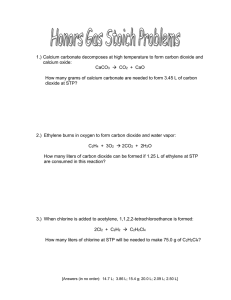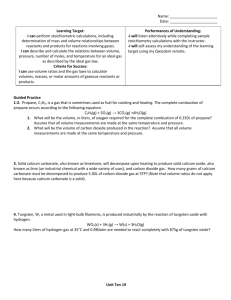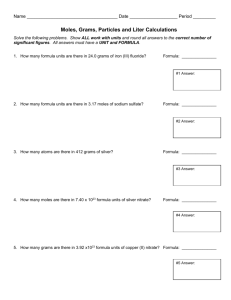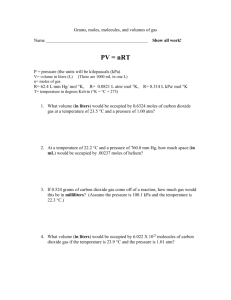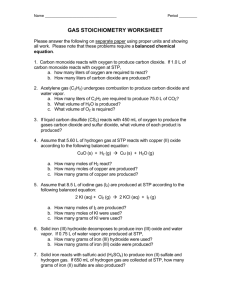Gas Stoichiometry Worksheet
advertisement
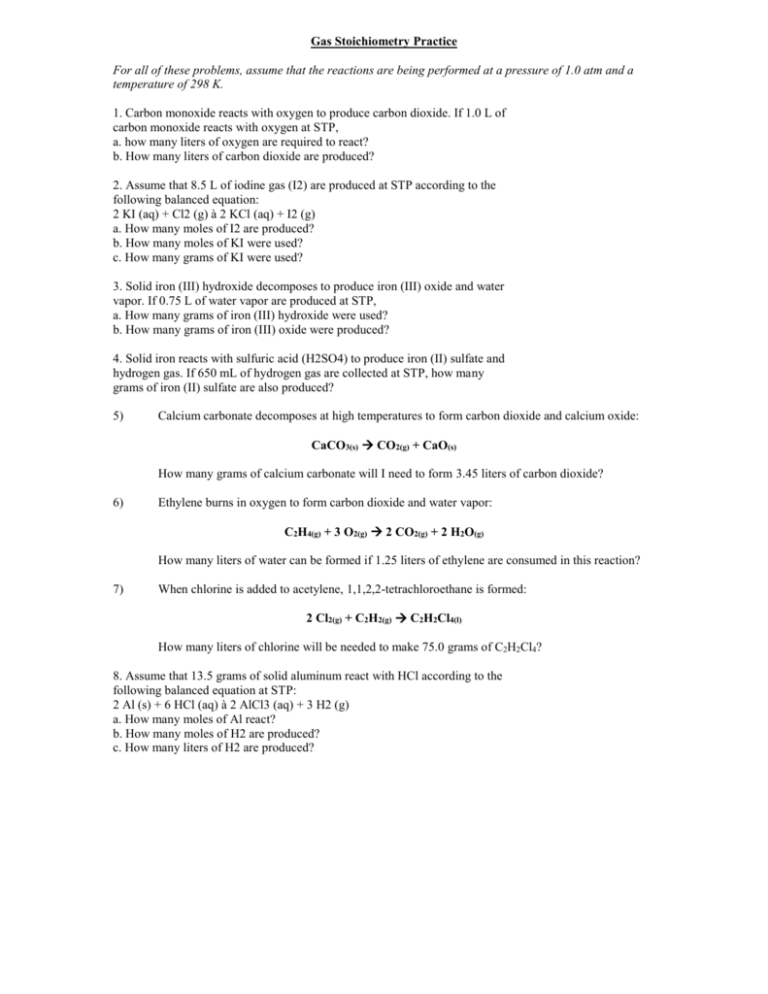
Gas Stoichiometry Practice For all of these problems, assume that the reactions are being performed at a pressure of 1.0 atm and a temperature of 298 K. 1. Carbon monoxide reacts with oxygen to produce carbon dioxide. If 1.0 L of carbon monoxide reacts with oxygen at STP, a. how many liters of oxygen are required to react? b. How many liters of carbon dioxide are produced? 2. Assume that 8.5 L of iodine gas (I2) are produced at STP according to the following balanced equation: 2 KI (aq) + Cl2 (g) à 2 KCl (aq) + I2 (g) a. How many moles of I2 are produced? b. How many moles of KI were used? c. How many grams of KI were used? 3. Solid iron (III) hydroxide decomposes to produce iron (III) oxide and water vapor. If 0.75 L of water vapor are produced at STP, a. How many grams of iron (III) hydroxide were used? b. How many grams of iron (III) oxide were produced? 4. Solid iron reacts with sulfuric acid (H2SO4) to produce iron (II) sulfate and hydrogen gas. If 650 mL of hydrogen gas are collected at STP, how many grams of iron (II) sulfate are also produced? 5) Calcium carbonate decomposes at high temperatures to form carbon dioxide and calcium oxide: CaCO3(s) CO2(g) + CaO(s) How many grams of calcium carbonate will I need to form 3.45 liters of carbon dioxide? 6) Ethylene burns in oxygen to form carbon dioxide and water vapor: C2H4(g) + 3 O2(g) 2 CO2(g) + 2 H2O(g) How many liters of water can be formed if 1.25 liters of ethylene are consumed in this reaction? 7) When chlorine is added to acetylene, 1,1,2,2-tetrachloroethane is formed: 2 Cl2(g) + C2H2(g) C2H2Cl4(l) How many liters of chlorine will be needed to make 75.0 grams of C2H2Cl4? 8. Assume that 13.5 grams of solid aluminum react with HCl according to the following balanced equation at STP: 2 Al (s) + 6 HCl (aq) à 2 AlCl3 (aq) + 3 H2 (g) a. How many moles of Al react? b. How many moles of H2 are produced? c. How many liters of H2 are produced? Gas Stoichiometry Practice - Solutions For all of these problems, assume that the reactions are being performed at a pressure of 1.0 atm and a temperature of 298 K. 1) Calcium carbonate decomposes at high temperatures to form carbon dioxide and calcium oxide: CaCO3(s) CO2(g) + CaO(s) How many grams of calcium carbonate will I need to form 3.45 liters of carbon dioxide? 14.1 grams 2) Ethylene burns in oxygen to form carbon dioxide and water vapor: C2H4(g) + 3 O2(g) 2 CO2(g) + 2 H2O(g) How many liters of water can be formed if 1.25 liters of ethylene are consumed in this reaction? 2.50 liters 3) When chlorine is added to acetylene, 1,1,2,2-tetrachloroethane is formed: 2 Cl2(g) + C2H2(g) C2H2Cl4(l) How many liters of chlorine will be needed to make 75.0 grams of C2H2Cl4? 21.8 L
